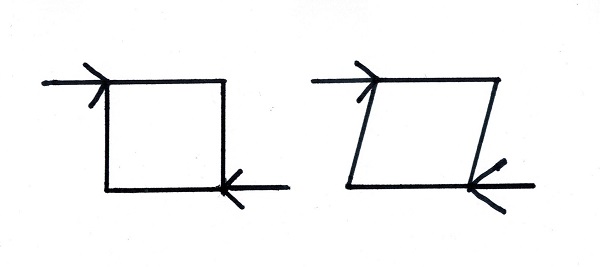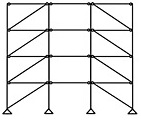Lateral loads
Lateral loads are live loads that are applied parallel to the ground; that is, they are horizontal forces acting on a structure. They are different to gravity loads for example which are vertical, downward forces.
The most common types are:
Wind load may not be a significant concern for small, massive, low-level buildings, but becomes more importance with height, the use of lighter materials and the use of shapes that may affect the flow of air, typically roof forms.
Significant seismic loads can be imposed on a structure during an earthquake. They are likely to be relatively instantaneous loads compared to wind loads. Buildings in areas of seismic activity need to be carefully designed to ensure they do not fail if an earthquake should occur.
Water pressure tends to exert a lateral load which increases linearly with depth and is proportional to the liquid density. Similarly, earth pressure (such as settlement) can be applied against below-ground structures such as basement walls, retaining walls, and so on.
Lateral loads such as wind load, water and earth pressure have the potential to become an uplift force (an upward pressure applied to a structure that has the potential to raise it relative to its surroundings). For more information, see Uplift force.
Structures should be designed carefully with likely lateral loads in mind. A structural element that is typically used to resist lateral loads is a shear wall. In simple terms, lateral forces could push over parallel structural panels of a building were it not for perpendicular shear walls keeping them upright. For more information see: Shear wall.
Similarly, bracing can be used to resist lateral loads. The beams and columns of a braced frame structure carry vertical loads, whilst the bracing carries the lateral loads. For more information, see Braced frame structure.
[edit] Related articles on Designing Buildings Wiki
- Bearing capacity.
- Bending moment.
- Biaxial bending.
- Braced frame.
- Dead loads.
- Floor loading.
- Force.
- Ground heave.
- Hurricane design considerations.
- Limit state design.
- Live loads.
- Loadbearing capacity.
- Moment.
- Point of contraflexure.
- Settlement of buildings.
- Shear force.
- Shear wall.
- Structural engineer.
- The design of temporary structures and wind adjacent to tall buildings.
- Torsion.
- Types of structural load.
- Uniformly Distributed Load.
- Uplift force.
- Vibrations.
- Wind load.
Featured articles and news
The benefits of engaging with insulation manufacturers
When considering ground floor constructions.
Lighting Industry endorses Blueprint for Electrification
The Lighting Industry Association fully supports the ECA Blueprint as a timely, urgent call to action.
BSRIA Sentinel Clerk of Works Training Case Study
Strengthening expertise to enhance service delivery with integrated cutting-edge industry knowledge.
Impact report from the Supply Chain Sustainability School
Free sustainability skills, training and support delivered to thousands of UK companies to help cut carbon.
The Building Safety Forum at the Installershow 2025
With speakers confirmed for 24 June as part of Building Safety Week.
The UK’s largest air pollution campaign.
Future Homes Standard, now includes solar, but what else?
Will the new standard, due to in the Autumn, go far enough in terms of performance ?
BSRIA Briefing: Cleaner Air, Better tomorrow
A look back at issues relating to inside and outside air quality, discussed during the BSRIA briefing in 2023.
Restoring Abbotsford's hothouse
Bringing the writer Walter Scott's garden to life.
Reflections on the spending review with CIAT.
Retired firefighter cycles world to raise Grenfell funds
Leaving on 14 June 2025 Stephen will raise money for youth and schools through the Grenfell Foundation.
Key points for construction at a glance with industry reactions.
Functionality, visibility and sustainability
The simpler approach to specification.
Architects, architecture, buildings, and inspiration in film
The close ties between makers and the movies, with our long list of suggested viewing.
SELECT three-point plan for action issued to MSPs
Call for Scottish regulation, green skills and recognition of electrotechnical industry as part of a manifesto for Scottish Parliamentary elections.
UCEM becomes the University of the Built Environment
Major milestone in its 106-year history, follows recent merger with London School of Architecture (LSE).
Professional practical experience for Architects in training
The long process to transform the nature of education and professional practical experience in the Architecture profession following recent reports.
























